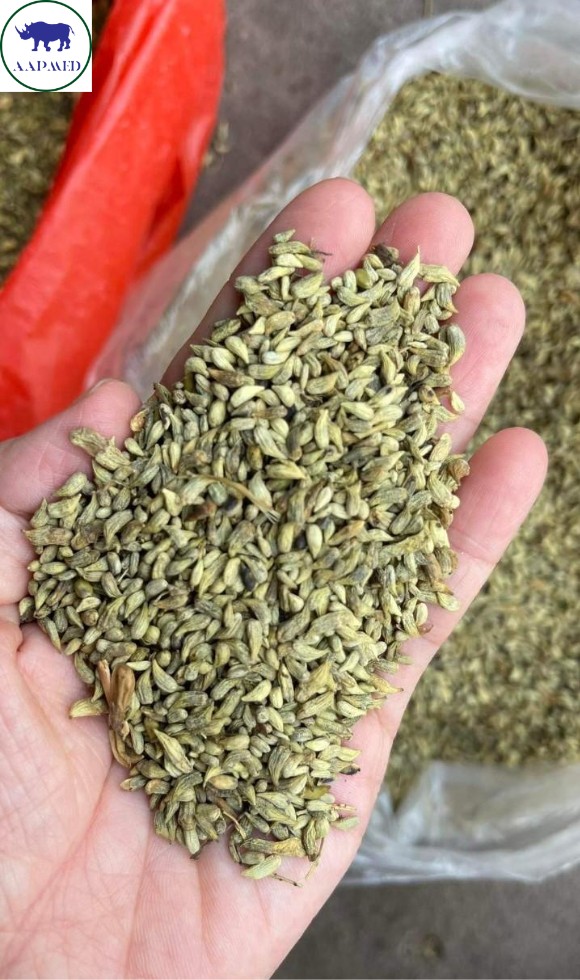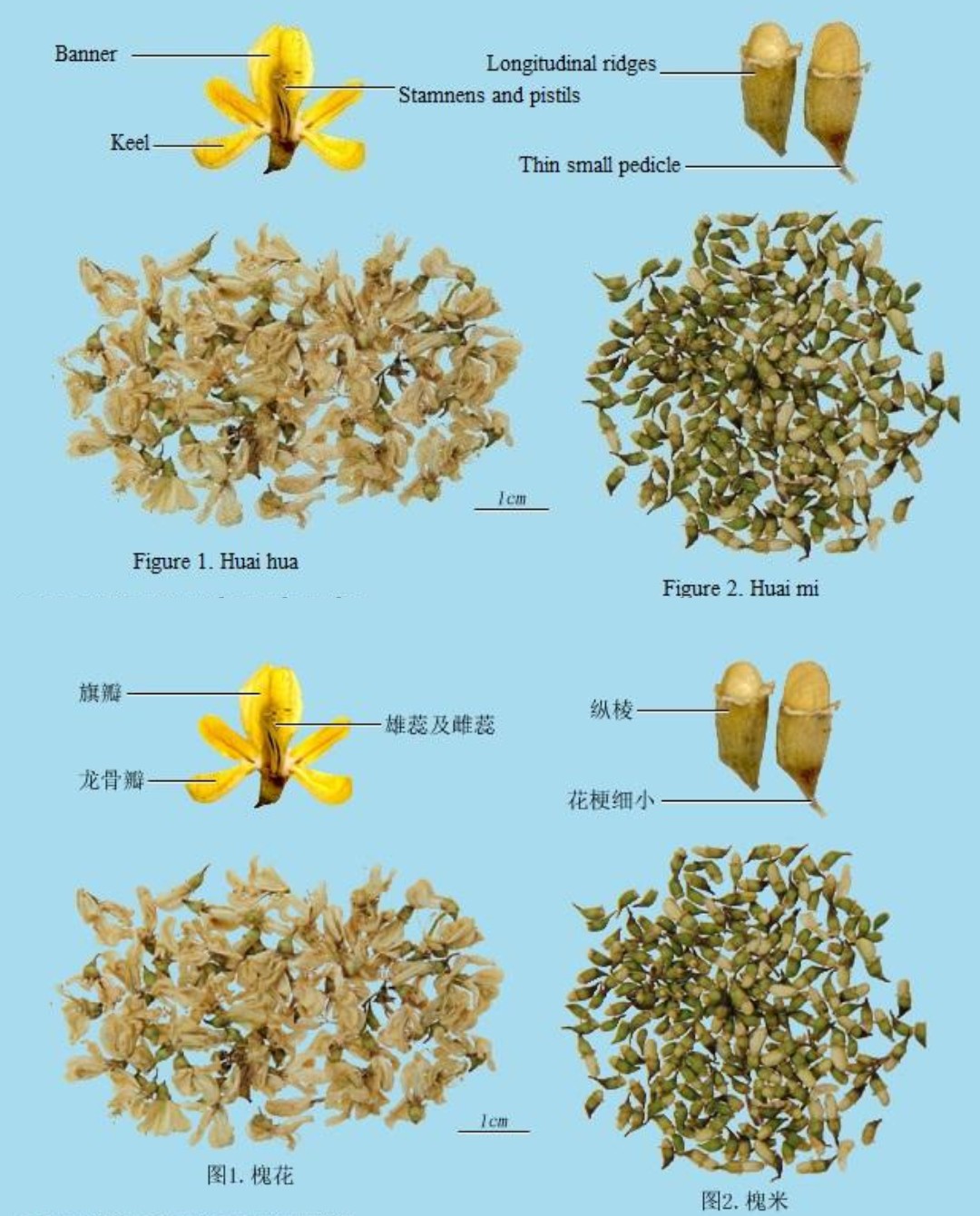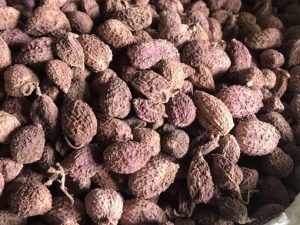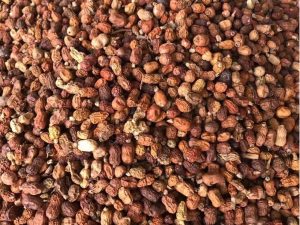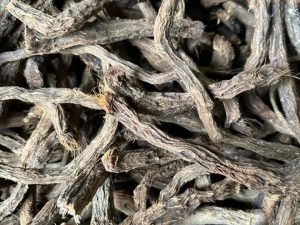Huaihua – 槐花 – Black Locust Flower
Huaihua – 槐花 – Black Locust Flower
Chinese Name 槐花
Chinese Pinyin Huaihua
English Name Black Locust Flower
– Science Name / Latin Pharmaceutical Name: Sophora japonica L.
– Parts of plants that have useful value: dried flowers and buds. Chinese name: flowers: Huaihua. Buds: Huaimi. Fruits: Huaijiao.
– Origin: The dried flower and flower bud of Sophora japonica L.(Fabacaea)
Huaihua – 槐花 – Black Locust Flower
中文名稱: 槐花
漢語拼音: Huaihua
英文名稱: Pagoda-tree; Black Locust Flower
– 拉丁學名: Sophorae Flos, Sophora japonica L
– 類別: 花類
– 來源: 豆科植物槐Sophora japonica L. 的乾燥花及花蕾。
– 科屬歸類: 豆科 Fabaceae, 槐屬 Sophora
Description
Huaihua – 槐花 – Black Locust Flower
Chinese Name 槐花
Chinese Pinyin Huaihua
English Name Black Locust Flower
– Science Name / Latin Pharmaceutical Name: Sophora japonica L.
– Parts of plants that have useful value: dried flowers and buds. Chinese name: flowers: Huaihua. Buds: Huaimi. Fruits: Huaijiao.
– Origin: The dried flower and flower bud of Sophora japonica L.(Fabacaea)
-
- Distribution: Growing on mountain slopes and plains. Can be cultivated in gardens. Widely cultivated in all parts of China. Also found in Japan and North Korea. The medicinal materials are mainly produced in Hebei, Shanxi, Shandong, Henan, Jiangsu, Tianjin, Beijing and etc. Produced most in Hebei, Shandong and Henan.
- Description: Deciduous tree, 8-25m high. Bark grey or greyish brown, with irregular longitudinal dehiscence, inner bark bright yellow with bad smell; Twigs dark greenish brown, nearly smooth or with short fuzz, lenticels conspicuous, branches brown. Odd pinnate compound leaves, alternate, 15-25cm long, rachis hairy, base dilated; Lobule 7-15, papyraceous, stipe ca. 2mm long, dense white pubescence; stipules falcate, caducous; Leaflet blades ovate-oblong or ovate-lanceolate, 2.5-7.5cm long, 1.5-3cm wide, apex acuminate, with minute cusp, base rounded or broadly cuneate, entire, green above, slightly bright, dorsal surface with prostrate white short hair, small stipules 2, subulate. Panicle terminal, 15-30cm long, often being pyramid-shaped, pedicels shorter than calyx; calyx campanulate, 5-lobed, calyx tube nearly glabrous; corolla butterfly, milky white, vexil broadly cordate, length and width about 11mm, with short claw, veins purplish, apex emarginate, base shallowly cordate, petals and keel long and round; stamens 10, nearly separated, unequal in length, persistent; ovary cylindrical, with thin and long hair, styles bent. Pod carnose, beaded, 2.5-5cm long, nodular, yellowish green, glabrous, not split, very constricted between the seeds. Seeds 1-6, reniform, yellowish green, dark brown after drying. Flowering: July to August, fruiting: October to November.
- Macroscopic Features: Wrinkled and rolled, petals often fell off; intact flower has bell-like calyx, yellowish-green; petal is yellowish white or yellow. Light in weight; slightly bitter taste. Flower bud (huai mi) is oval or elliptical shape, with yellowish-green calyx; top is yellowish-white patel of non-opened flower; externally yellowish-brown. Light in weight. Slightly bitter and astringent taste.
- Harvest & Processing: Dry flowers and bud: collected in summer when flowering or budding and dried timely, removed branch, stem and foreign matters. Fruits: collected in winter, removed foreign matters and dried.
- Used Medical Part: dried flowers and buds. Chinese name: flowers: Huaihua. Buds: Huaimi. Fruits: Huaijiao.
- Chemistry: Dry flower and bud mainly contain flavonoid glycosides, steroids and tannins, etc. Fruit mainly contain flavonoids, alkaloids and amino acids, etc.
- Pharmacology: Dry flower and bud: antibacterial, analgesic, blood-coagulating and hemostatic. Fruit: blood-sugar-increasing; antioxidant, cholesterol-reducing and anti-inflammatory.
- Properties & Actions: Dry flower and flower bud: bitter, little cold. Fruits: bitter, cold.Dry flowers and buds: cooling blood, arresting bleeding, clearing liver and discharging fire. Fruit: cooling blood, arresting bleeding, clearing heat and discharging fire.
- Quality Requirements: Superior medicinal material is yellowish-green, large, tight.
- Indications & Usage, Dried flowers and buds: Cools blood, stops blood, clears the liver, drains fire. Apply to hemafecia due to intestinal wind,
hematodiarrhea, metrorrhagia and metrostaxis, hematemesis, non-traumatic hemorrhage, hemafecia, hemorrhoid hemorrhage, conjunctival congestion due to hepatic heat, headache, headache due to live fire, conjunctival congestion ans swellingpain, throat impediment, aphonia, abscess, sore and vertigo.- Fruits: headache due to hepatic heat, vertigo and conjunctival congestion, hemafecia due to intestinal heat, piles and hemorrhage.
- Dry flower and bud: oral administration: decocting, 5-9g. Use with care in case of yin-deficiency, fever or deficiency-cold of spleen and stomach.
- Fruit: oral administration: decocting, 6-9g. Use with care in case of deficiency-cold of spleen and stomach, diarrhea or pregnancy.
- Examples
- Hemorrhage of large intestine: pagoda-tree flower, catnip spike in equal amounts. Grind into powder, swallow with liquor 1 qian.
- Sudden heat hemorrhage: fresh pig intestine 1 piece, wash clean, dry the moisture, stir-fry pagoda-tree flower, stir fry in rice vinegar, cook in a pot, pestle and prepare pills as large as marble, and pills will be dried in a day. Take 1 pill each day on empty stomach, decoct angelica with liquor, and swallow.
- Profuse uterine bleeding: aged pagoda-tree flower 1 liang, plant soot 0.5 liang. Grind into powder. Take 3-4 qian each time, swallow with warm liquor; if the patient is unconscious, burn the bob to red hot, and swallow the pill with liquor.
Huaihua – 槐花 – Black Locust Flower
中文名稱: 槐花
漢語拼音: Huaihua
英文名稱: Pagoda-tree; Black Locust Flower
– 拉丁學名: Sophorae Flos, Sophora japonica L
– 類別: 花類
– 來源: 豆科植物槐Sophora japonica L. 的乾燥花及花蕾。
– 科屬歸類: 豆科 Fabaceae, 槐屬 Sophora
-
- 植物形態: 落葉喬木,高8-25米。樹皮灰色或灰棕色,具不規則縱裂,內皮鮮黃色,具臭味;嫩枝暗綠褐色,近光滑或有短細毛,皮孔明顯,枝棕色。奇數羽狀複葉,互生,長15-25厘米,葉軸有毛,基部膨大;小葉7-15,紙質,柄長約2毫米,密生白色短柔毛;托葉鐮刀狀,早落;小葉片卵狀長圓形或卵狀披針形,長2.5-7.5厘米,寬1.5-3厘米,先端漸尖,具細突尖,基部圓形或寬楔形,全緣,上面綠色,微亮,背面伏生白色短毛,小托葉2,鉆狀。圓錐花序頂生,長15-30厘米,常呈金字塔狀,花梗比花萼短;萼鐘狀,5淺裂,萼管近無毛;花冠蝶形,乳白色,旗瓣闊心形,長寬約11毫米,有短爪,脈微紫,先端微缺,基部淺心形,翼瓣和龍骨瓣均為長圓;雄蕊10,近分離,不等長,宿存;子房筒狀,有細長毛,花柱彎曲。莢果肉質,串珠狀,長2.5-5厘米,有節,黃綠色,無毛,不開裂,種子間極細縮。種子1-6顆,腎形,淡黃綠色,乾後黑褐色。花期7-8月,果期10-11月。
- 性狀: 皺縮而捲曲,花瓣多散落,完整者花萼鐘狀,黃綠色,花瓣黃色或黃白色。體輕。味微苦。花蕾 (槐米) 卵形或橢圓形。花萼黃綠色,上方為未開放的黃白色花瓣,內呈黃褐色。質輕。味微苦澀。
- 生境分佈: 生於山坡,平原或植於庭園。 中國各地普遍栽培。日本和朝鮮也有。 藥材主產於河北、山東、河南、江蘇、天津、北京等地。以河北、山東、山西、河南產量大。
- 採收加工: 乾燥花及花蕾: 夏季花開放或花蕾形成時採收,及時乾燥,除去枝、梗及雜質。果實: 冬季採收,除去雜質,乾燥。
- 藥用部位: 以乾燥花及花蕾,入藥。中藥名: 槐花(花),槐米(花蕾),果實(槐角)
- 主要成分: 乾燥花及花蕾: 主要含黃酮苷類,甾體類,鞣質等成分。果實: 主要含黃酮類,生物鹼類,胺基酸類等成分。
- 藥理作用: 乾燥花及花蕾: 抗菌,止痛,凝血,止血。果實: 提高血糖: 抗氧化,降膽固醇,抗炎。
- 性味功能: 乾燥花及花蕾: 苦,微寒。果實: 苦,寒。乾燥花及花蕾: 涼血止血,清肝瀉火。果實: 涼血止血,清熱瀉火。
- 品質: 以黃綠色、粒大、緊實者為佳。
- 功效: 涼血止血,清肝瀉火。主治腸風便血,痔血,血痢,尿血,血淋,崩漏,吐血,衄血,肝火頭痛,目赤腫痛,喉痹,失音,癰疽瘡瘍。
- 主治:
- 乾燥花及花蕾: 血痢,崩漏,便血,肝熱目赤,頭痛眩暈。
- 果實: 肝熱頭痛、眩暈目赤,腸熱便血、痔腫出血。
- 用法: 乾燥花及花蕾: 內服: 煎湯,5-9克。陰虛發熱而無實火及脾胃虛寒者慎服。果實: 內服: 煎湯,6-9克。脾胃虛寒、食少便溏及孕婦慎服。
- 應用舉例
- 炙品炒槐花:取淨槐花,置預熱炒制容器內,用文火加熱,炒至深黃色,取出晾涼。具香氣。苦寒之性緩和,並破壞了酶的活性,利於保存有效成分。其清熱涼血作用弱於生品,止血作用遜於槐花炭而強於生品,用於脾胃虛弱的出血患者。
- 槐花炭:取淨槐花,置預熱炒制容器內,用中火加熱,炒至焦褐色,噴灑少許清水,滅盡火星,炒乾,取出晾涼。質輕,味澀。清熱涼血作用極弱,收澀之性增強,偏於止血。用於咯血、衄血、便血、痔血、崩漏下血等多種出血證。
- 大腸下血: 槐花、荊芥穗等分。為末,酒服一錢匕。(經驗方)
- 暴熱下血: 生豬髒一條,洗淨,控乾,以炒槐花末填滿紮定,米醋炒,鍋內煮爛,擂,丸彈子大,日乾。每服一丸,空心,當歸煎酒化下。(永類鈐方)
- 血崩: 陳槐花一兩,百草霜半兩。為末。每服三、四錢,溫酒調下;若昏憒不省人事,則燒紅秤錘淬酒下。(良朋彙集)


